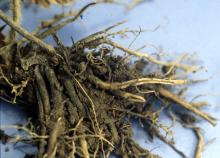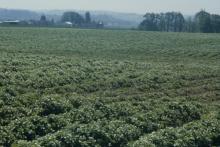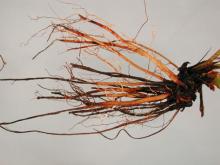See:
Strawberry (Fragaria spp.) - Crown Rot
Strawberry Cultivar Susceptibility
Cause Phytophthora fragariae var. fragariae, a soil-infesting fungus-like microorganism that may live many years in fields. It is active in cool, wet weather. It attacks roots soon after fall rains begin and remains active through winter, spreading most rapidly where drainage is poor or in heavier soils. Well-drained fields are less often attacked, but low areas often show typical red stele infection.
Several races of the fungus-like microorganism have been reported. A cultivar resistant in one field may be susceptible in another field due to the presence of different races. Of the seven races described, five have been reported from Oregon and Washington. Cultivars used to determine races include Aberdeen, Climax, Stelemaster, Sure-crop, Tennessee Beauty, MD-683, and a clone of F. chiloensis 'Del Norte'.
Symptoms The core or stele of diseased roots in winter and spring has a reddish pink tinge gradually turning a cinnamon-brown while the root's outer cortex stays white. Ultimately the diseased core turns black. Most of the plant's main roots show the symptom, but after May it is difficult to see. Cut roots lengthwise to expose the core. Lateral roots are quickly destroyed, giving main roots a "rat tail" appearance. As the disease progresses and active spring growth begins, infected plants are undernourished. Aboveground symptoms depend on the extent of root damage. Slightly diseased plants show few symptoms, if any. Severely diseased plants are stunted, and under certain conditions the youngest leaves take on a bluish-green tinge and lack normal glossiness. Older leaves generally turn red, orange, or yellow. Such plants eventually wilt and die.
Cultural control
- Use certified plants only.
- Set new plants in well-drained soil (no standing water in winter) where red stele has not been known.
- Plant on beds raised 8 to 10 inches to improve drainage, or use drain furrows. In home gardens or small plantings, raise the bed 15 inches.
- Preplant soil solarization has been helpful in reducing populations of certain soilborne pathogens and weeds in western Oregon. Place clear plastic (preferably anti-condensation film) directly on smooth, rototilled ground, which has been irrigated to field capacity and then allowed to drain for 1-2 days. Bury the edges of the plastic to trap the heat. Solarize for 4 to 6 weeks (or longer) during the hottest part of the summer, beginning in early- to mid-July. Use in combination with other techniques.
- Do not plant in draws or swales where surface water flows after heavy rains.
- Chisel or subsoil 18 to 20 inches deep between rows in late fall to increase drainage.
- Clean soil from equipment before using it in other fields.
- Resistant cultivars such as Olympus, Hood, Totem, Rainier, and Shuksan are available, but even these are infected sometimes if virulent races of the pathogen are in soil.
Chemical control Research data are based on chemical programs initiated at planting. Curative treatments may give some benefit but are not recommended. The FRAC 4 and FRAC P7 fungicides used to manage Phytophthora do not kill this organism. They can only prevent establishment of the organism before it gets into the plant. They can also prevent continued growth if the organism is already inside the plant, thereby delaying symptoms that might have developed. Once chemical activity has subsided with time, the organism can resume growth within infected plants. Alternate between chemicals with different modes of action to prevent or delay building up resistant microorganisms. Red stele microorganisms resistant to Ridomil have been detected in the major strawberry-growing areas of the Willamette Valley of Oregon.
- Agri-Fos at 1.25 to 2.5 quarts/A. Group P7 fungicide. 4-hr reentry. Washington only.
- Aliette WDG at 2.5 to 5 lb/A. Do not use with adjuvants. Apply when plants resume growth in spring; continue at 30- to 60-day intervals. Apply no more than twice in spring and twice in fall. Can be applied on day of harvest but with a 12-hr preharvest interval. Do not apply within 30 days of harvest in British Columbia. Group P7 fungicide. 12-hr reentry.
- Fosphite at 1 to 3 quarts/A. Do not use copper products within 20 days of treatment and do not use spray adjuvants. Group P7 fungicide. 4-hr reentry.
- MetaStar 2E at 2 quarts/A. Group 4 fungicide. 48-hr reentry.
- Monterey Garden Phos at 2 to 6 teaspoons/gal water as a foliar spray. Group P7 fungicide. H
- Orondis Gold at 20 to 62 fl oz/A as a drip application through irrigation water. Do not use within 28 days of harvest. Group 4 + 49 fungicide. 48-hr reentry.
- OxiPhos at 2.5 to 5 quarts/A as a foliar spray. Group P7 fungicide. 4-hr reentry.
- Phostrol at 2.5 to 5 pint/A. Group P7 fungicide. 4-hr reentry.
- Rampart at 1 to 3 quarts/100 gal water/A. Group P7 fungicide. 4-hr reentry.
- Ridomil Gold SL at 1 pint/A. Apply once at planting and again in spring as plants begin to grow. Apply again in fall after harvest but before fall rains. May be applied up to and including the day of harvest. Only the fall application is allowed in British Columbia, before November 30. Group 4 fungicide. 48-hr reentry.
References Milholland, R.D., Cline, W.O., and Daykin, M.E. 1989. Criteria for identifying pathogenic races of Phytophthora fragariae on selected strawberry genotypes. Phytopathology 79:535-538.
Pinkerton, J.N., Ivors, K.L., Reeser, P.W., Bristow, P.R., and Windom, G.E. 2002. The use of soil solarization for the management of soilborne plant pathogens in strawberry and red raspberry production. Plant Disease 86:645-651.



